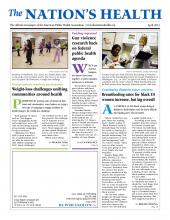Do you find yourself reaching for the salt shaker at the dinner table to give your meal a boost of flavor? You might want to hold off. Chances are your meal might already be loaded with one component of your table salt: sodium.
A diet filled with sodium can lead to chronic health issues such as high blood pressure, hypertension and heart disease, says Kathryn McMurry, MS, a nutrition coordinator at the National Heart, Lung and Blood Institute. The risk for high blood pressure increases with age and there is a 90 percent chance that an adult will develop high blood pressure in her or his lifetime, she says.
“As we’re younger it’s not an immediate issue, but our taste preferences are formed when you’re younger, and the sooner we start to modify that intake, the more likely we’ll be able to reduce the risk of developing high blood pressure,” McMurry says.
The average person consumes 3,300 milligrams — or as many as two cheeseburgers — of sodium daily when we really should have no more than 2,300 milligrams daily, McMurry says. Get ready to slash that to 1,500 milligrams per day if you’re older than 51, or have chronic conditions such as diabetes or kidney disease, according to the Centers for Disease Control and Prevention.

photos courtesy iStockphoto: pizza man, Amanda Rohde
Foods such as canned soup, burgers and pizza will knock out your daily allowance of sodium in one sitting, McMurry says. But sodium can also be found in baking powder. It’s in the leavening agents that help bread rise. Even meats labeled as “fresh” may be covered in brine filled with sodium, she says.
“It’s really hidden in a lot of foods,” McMurry says. “It’s not an intentional plot by the food industry, but it serves a function in foods to preserve them.”
With an abundance of sodium in many popular foods, lowering your intake can be tricky. But there are steps you can take to lower your intake while food shopping, eating at home and dining out.
When shopping for food, always remember to look at nutrition fact labels and compare products, McMurry says. Search for plain foods that say “no salt added” on the box. Look for products without additional seasoning or marinades so you can control the amount of salt you put in your food, she says.
Even if something is labeled as fresh, it’s always a good idea to look at the label andsee how much sodium is in it, McMurry says.
“Even some of the frozen vegetables, their seasonings can add about 200 milligrams more sodium,” McMurry says. “You think you’re buying more flavor, but you’re also getting sodium along with it.”
When cooking at home, start with basic ingredients, McMurry says. Only add enough salt to taste, but use items such as lemon juice, herbs and balsamic vinegar for flavor. Remember to rinse off canned foods such as vegetables. Those may have been preserved in a salty liquid, McMurry says. Packaged foods such as rice and pasta may already come with seasonings, so try using only half the amount of seasoning instead, she says.
If you’re eating out, there may be a chance your restaurant knows its customers are trying to be heart healthy, too. Some chains use symbols on their menus to denote which items have lower sodium or calories. Use this as a guide when deciding to choose what entree to order, McMurry says.
Also, do your homework before you get to the restaurant. Check out the menu online — if it’s available — for nutrition facts. Once you’re there and the meal arrives, ask for a takeout bag before you take a bite. Chances are you won’t be able to finish the entire meal and you can save half for the next day, McMurry says.
Because most of the food you eat contains loads of sodium, you’re probably used to eating salty food. Once you take steps to eat foods with reduced sodium, you’ll notice theflavor of your foods start to change. Foods that never used to taste salty will taste even saltier as a result, she says.
It is best to make small changes over time with everything you eat, McMurry says.
“It’s sort of a gradual shift you need to do,” McMurry says. “It’s often very hidden in the food and it’s hard to tell how much you’re getting, especially when you’re eating out.”
Unexpected sources of sodium
Some of the foods we crave the most are filled with high amounts of sodium. However, there are foods you may not realize contain it. The Centers for Disease Control and Prevention says more than 40 percent of sodium comes from these foods:
Breads and rolls
Cold cuts and cured meats
Sandwiches
Pasta dishes
Meat dishes
Cheese
Pizza
Poultry
Soups
- Copyright The Nation’s Health, American Public Health Association









